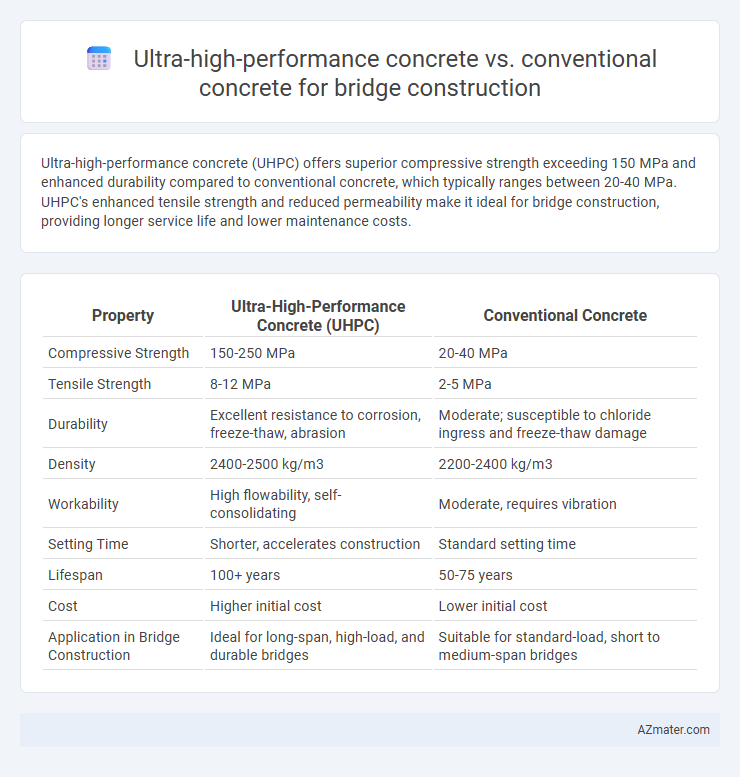Ultra-high-performance concrete (UHPC) offers superior compressive strength exceeding 150 MPa and enhanced durability compared to conventional concrete, which typically ranges between 20-40 MPa. UHPC's enhanced tensile strength and reduced permeability make it ideal for bridge construction, providing longer service life and lower maintenance costs.
Table of Comparison
| Property | Ultra-High-Performance Concrete (UHPC) | Conventional Concrete |
|---|---|---|
| Compressive Strength | 150-250 MPa | 20-40 MPa |
| Tensile Strength | 8-12 MPa | 2-5 MPa |
| Durability | Excellent resistance to corrosion, freeze-thaw, abrasion | Moderate; susceptible to chloride ingress and freeze-thaw damage |
| Density | 2400-2500 kg/m3 | 2200-2400 kg/m3 |
| Workability | High flowability, self-consolidating | Moderate, requires vibration |
| Setting Time | Shorter, accelerates construction | Standard setting time |
| Lifespan | 100+ years | 50-75 years |
| Cost | Higher initial cost | Lower initial cost |
| Application in Bridge Construction | Ideal for long-span, high-load, and durable bridges | Suitable for standard-load, short to medium-span bridges |
Introduction to Bridge Construction Materials
Ultra-high-performance concrete (UHPC) offers superior compressive strength, durability, and resistance to environmental factors compared to conventional concrete, making it ideal for modern bridge construction. UHPC's dense microstructure reduces permeability, enhancing longevity and minimizing maintenance costs in harsh exposure conditions commonly faced by bridges. Conventional concrete remains widely used due to cost efficiency and established construction practices but often requires thicker sections to achieve similar performance levels.
Defining Ultra-High-Performance Concrete (UHPC)
Ultra-High-Performance Concrete (UHPC) is a superior material characterized by its exceptional compressive strength exceeding 150 MPa and enhanced durability compared to conventional concrete, which typically ranges from 20 to 40 MPa. UHPC incorporates fine powders, fibers, and optimized particle packing to achieve dense microstructure and high tensile strength, enabling longer span bridges with reduced cross-sections. Its enhanced resistance to environmental degradation and fatigue makes UHPC an ideal choice for advanced bridge construction where longevity and structural efficiency are critical.
Overview of Conventional Concrete
Conventional concrete, commonly used in bridge construction, consists of cement, water, sand, and coarse aggregates, providing adequate compressive strength and workability for various structural applications. Its typical compressive strength ranges from 20 to 40 MPa, which supports a broad range of design requirements but may require thicker sections for durability and load-bearing capacity. Despite its affordability and ease of use, conventional concrete often suffers from lower tensile strength and increased permeability compared to ultra-high-performance concrete, necessitating additional reinforcement and maintenance in bridge structures.
Structural Properties: UHPC vs Conventional Concrete
Ultra-high-performance concrete (UHPC) exhibits superior structural properties compared to conventional concrete, including significantly higher compressive strength often exceeding 150 MPa versus 30-50 MPa for conventional mixes. UHPC features enhanced tensile strength and ductility due to fiber reinforcement, reducing crack propagation and improving durability in bridge construction. Its low permeability and exceptional bond strength with steel reinforcement increase resistance to corrosion and extend the lifespan of bridge structures.
Durability and Longevity Comparison
Ultra-high-performance concrete (UHPC) exhibits superior durability and longevity compared to conventional concrete in bridge construction due to its dense microstructure and enhanced resistance to chloride penetration, freeze-thaw cycles, and sulfate attack. UHPC's compressive strength often exceeds 150 MPa, significantly reducing microcracking and extending service life beyond 100 years under harsh environmental conditions. Conventional concrete, with typical compressive strengths between 20-40 MPa, is more susceptible to corrosion-induced deterioration and requires more frequent maintenance and repairs.
Cost Implications and Lifecycle Analysis
Ultra-high-performance concrete (UHPC) offers superior durability and strength, reducing maintenance and repair costs over the lifecycle of bridge construction compared to conventional concrete. Although UHPC has a higher initial material cost, its extended service life and enhanced resistance to environmental stressors can lead to lower total lifecycle expenses. Lifecycle analysis demonstrates that UHPC bridges experience fewer failures and reduced downtime, making them cost-effective despite the upfront investment.
Speed and Ease of Construction
Ultra-high-performance concrete (UHPC) significantly accelerates bridge construction due to its rapid strength gain, enabling earlier form removal and faster project turnover compared to conventional concrete. UHPC's superior flowability and self-consolidating properties reduce the need for extensive vibration and complex formwork, streamlining the placement process on-site. These characteristics result in decreased labor demands and shortened curing times, making UHPC a more efficient choice for time-sensitive bridge projects.
Environmental Impact and Sustainability
Ultra-high-performance concrete (UHPC) significantly reduces environmental impact in bridge construction by offering superior durability, which extends the service life and reduces the need for frequent repairs or replacements compared to conventional concrete. UHPC's dense microstructure minimizes permeability and corrosion risk, leading to enhanced sustainability through lower lifecycle carbon emissions and resource consumption. Despite higher initial material costs, UHPC supports sustainable infrastructure development by decreasing overall maintenance requirements and promoting long-term environmental benefits.
Case Studies: Bridges Using UHPC and Conventional Concrete
Case studies of bridge construction reveal that ultra-high-performance concrete (UHPC) offers superior durability, reduced maintenance, and enhanced load-bearing capacity compared to conventional concrete, as demonstrated by the Mars Hill Bridge in Tennessee and the First Avenue Bridge in Minnesota. UHPC's improved tensile strength and resistance to chlorine-induced corrosion contribute to extended service life, while conventional concrete remains widely used due to lower initial costs and established construction methods. Research from the Qingdao Jiaozhou Bay Bridge shows that integrating UHPC in critical bridge components significantly reduces crack propagation and structural degradation over time.
Future Trends in Bridge Construction Materials
Ultra-high-performance concrete (UHPC) is revolutionizing bridge construction by offering exceptional durability, higher compressive strength exceeding 150 MPa, and superior resistance to environmental degradation compared to conventional concrete. Future trends emphasize the integration of UHPC with advanced fiber reinforcement and sustainable materials to extend bridge lifespan and reduce maintenance costs. Innovations in mix design and 3D printing techniques are accelerating the adoption of UHPC for complex bridge geometries and modular construction methods.

Infographic: Ultra-high-performance concrete vs Conventional concrete for Bridge construction
 azmater.com
azmater.com